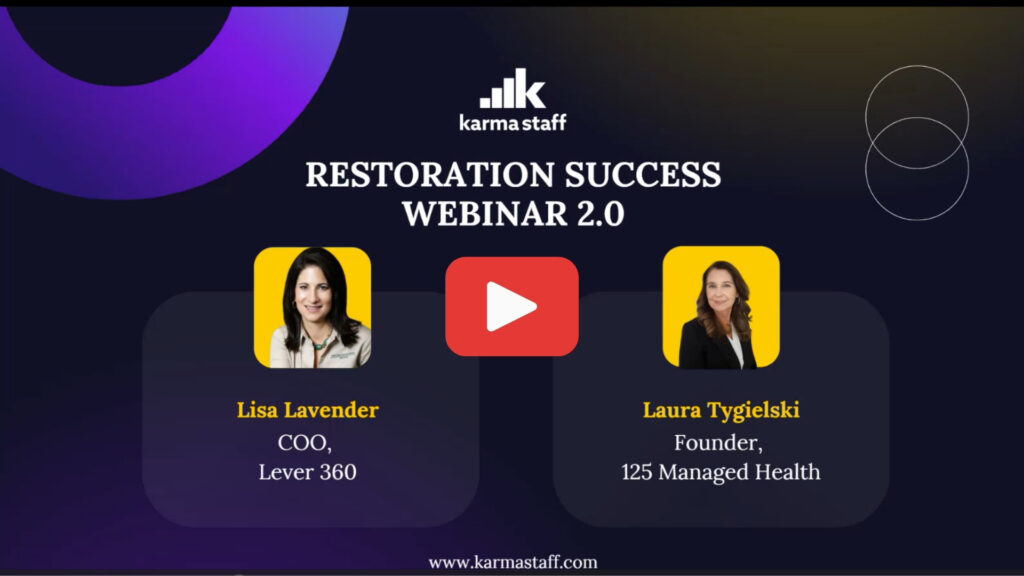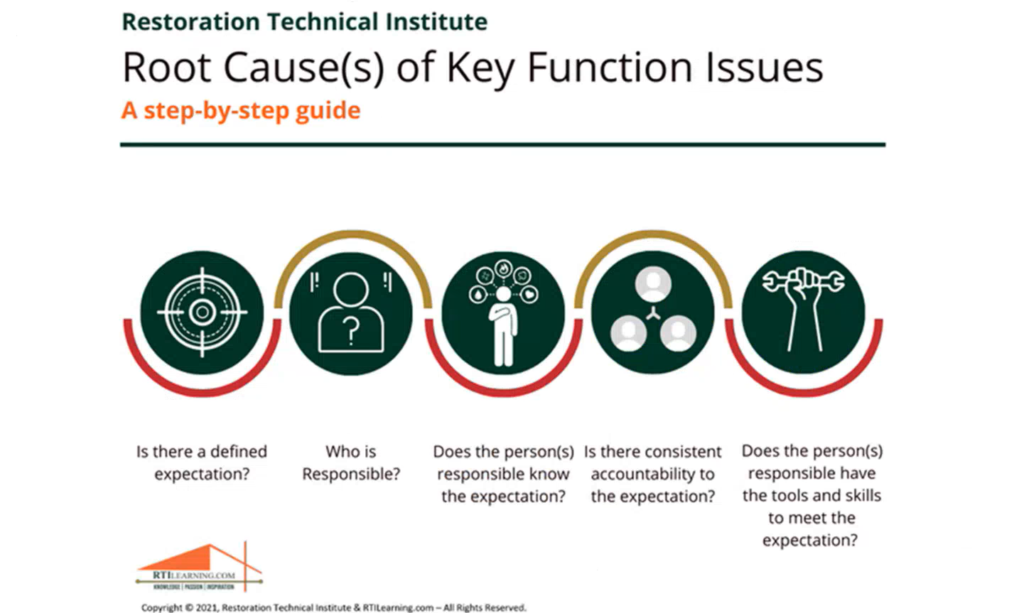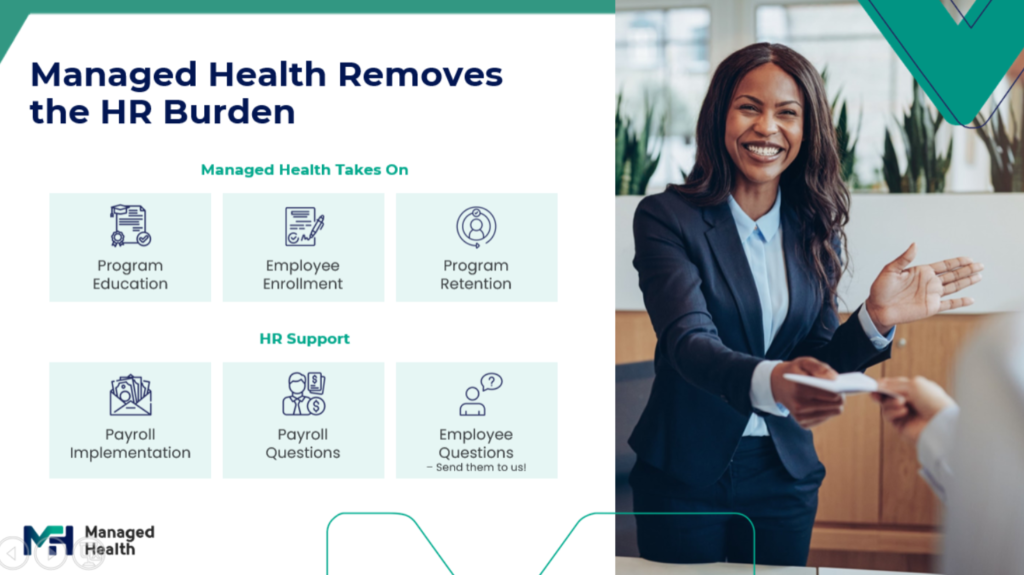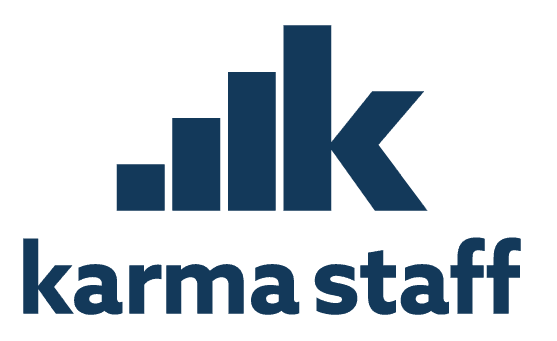The Restoration Success 2.0 Webinar, hosted by Karma Staff, delivered insightful strategies and actionable advice from industry leaders on improving efficiency, clarity, and cost management within restoration businesses. Moderated by Tenzin Wangjor, Marketing Director at Karma Staff, this session featured two distinguished speakers: Lisa Lavender, COO of Lever 360, and Laura Tygielski owner of 125 Managed Health.
Here are the key takeaways from this enlightening event:

Lisa Lavender on the Power of Clarity and Root Cause Analysis
Lisa Lavender, COO of Lever360, shared valuable insights on how restoration businesses can achieve success through clarity, defined expectations, and root cause analysis. Her presentation underscored the importance of organizational structure and functional clarity to drive efficiency and accountability.
Building a Functional Chart for Success
Lisa emphasized the need for creating a functional chart that maps out responsibilities within the company. Unlike traditional organizational charts, a functional chart focuses on functions, not people, helping businesses identify who owns which tasks.
Why Functional Charts Matter:
They improve communication, streamline accountability, and support scalability by clearly defining roles and responsibilities.
“When expectations are not met, the root cause often lies in unclear accountability. A functional chart ensures everyone knows what they are responsible for.”
Defining Clear Expectations
Lisa stressed the importance of clearly defined expectations to maintain consistency and accountability:
Actionable Tips:
Use “Time Speak”: Define tasks by the time they should take (e.g., cleaning an air mover in 7.5 minutes).
Ensure expectations are documented and communicated clearly through SOPs, work orders, and visual aids.

Root Cause Analysis Framework
Lisa shared a practical method for root cause analysis:
- Is there an expectation?
- Who is responsible?
- Does the person know the expectation?
- Is there consistent accountability?
- Do they have the tools and skills needed?
“Efficiency should never compromise quality. It’s about reducing unnecessary steps and optimizing workflows.”

Laura on Expense Efficiency and Managed Health Plans
Laura Tygielski, owner of 125 Managed Health, presented innovative ways to reduce business costs by implementing managed health plans and leveraging the IRS Section 125 tax code. Her insights highlighted how businesses can offer robust healthcare benefits at no net cost.
Reducing Healthcare Costs and Improving Employee Benefits
Laura introduced the Managed Health Plan — a preventive health program that offers zero-cost primary care, urgent care, and specialty visits for employees.
Key Benefits of Managed Health Plans:
- Zero Co-Pays: No co-pays for primary care, urgent care, and specialist visits.
- Prescription Savings: Access to over 3,000 prescriptions at wholesale prices.
- Telehealth: 24/7 access to medical and mental health services, enhancing employee well-being.
“Employees often skip medical care due to high costs. Managed Health Plans remove that barrier and promote healthier workforces.”
FICA Tax Savings
By adopting the managed health plan, employers can save approximately $500 per employee annually through reduced FICA taxes.
Additional Savings:
- Lower workers’ compensation claims as employees address health issues promptly.
- Reduced healthcare plan utilization, leading to lower renewal rates.

Employee Retention and Satisfaction
Providing these benefits can significantly reduce employee turnover by offering valuable incentives and fostering loyalty.
“A 95% participation rate shows employees value these benefits. It’s a win-win for employers and their teams.”
Q&A and Interactive Discussions
The webinar concluded with a dynamic Q&A session, addressing practical challenges faced by restoration businesses. Key themes included:
Balancing Efficiency with Quality:
Lisa emphasized that efficiency should optimize workflows without compromising quality.
Technology Adoption:
Implementing technology requires clear workflows and expectations to ensure smooth adoption.
Mental Health Benefits:
Laura highlighted the importance of mental health services in reducing absenteeism and improving overall employee well-being.
Special Thanks
A huge thank you to Lisa Lavender and Laura Tygielski for their valuable insights, and to Karma Staff for organizing this impactful webinar.
Stay tuned for upcoming webinars, and remember: Work on your business, not in your business!







